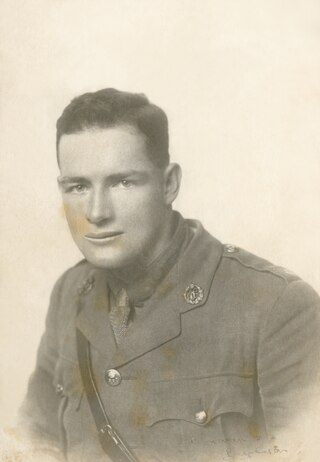Related Research Articles

Captain George Edward Henry McElroy MC & Two Bars, DFC & Bar was a leading Irish fighter pilot of the Royal Flying Corps and Royal Air Force during World War I. He was credited with 47 aerial victories.
Thomas Falcon Hazell & Bar was a fighter pilot with the Royal Flying Corps, and later, the Royal Air Force during the First World War. Hazell scored 43 victories in 1917–18 making him the fifth most successful British "flying ace" of the war, and the third most successful Irish-born pilot, behind Edward Mannock and George McElroy, as well the only pilot to survive the war from both groups.
Frank Ormond "Mongoose" Soden DFC & Bar was a First World War flying ace and RAF commander during the Second World War.
Captain Walter Alfred Southey was a British First World War flying ace, credited with twenty aerial victories, including five balloons, making him the second highest scoring ace in No. 84 Squadron, behind Andrew Beauchamp-Proctor.
Captain Robert Norwood Hall was a South African World War I flying ace credited with five aerial victories.
Captain Herbert James Hamilton was a World War I flying ace credited with seven aerial victories.
Major George Lawrence Lloyd was a Rhodesian-born flying ace of the First World War, credited with eight aerial victories.
Captain Horace Dale Barton was a World War I flying ace credited with 19 aerial victories.
Lieutenant Arthur Eden Reed was a South African World War I flying ace accredited with 19 aerial victories.
Lieutenant Colonel William Earle Molesworth was a British First World War flying ace credited with eighteen aerial victories.
Captain Sidney William Highwood was a British World War I flying ace and balloon buster credited with sixteen aerial victories.
Captain George Brian Gates was a British World War I flying ace credited with 15 aerial victories, twelve of them enemy aircraft, and three observation balloons.
Captain Robert Alexander Birkbeck, was a British World War I flying ace credited with 10 aerial victories.
Flight Lieutenant Francis James Davies was a British World War I flying ace credited with twelve aerial victories. He would briefly return to service during World War II.
Lieutenant D'Arcy Fowlis Hilton was a Canadian-born American World War I flying ace credited with eight aerial victories.
Captain Reginald Howard Rusby Distinguished Flying Cross|DFC was a World War I flying ace credited with ten aerial victories.
Captain Guy Borthwick Moore (1895–1918) was a Canadian World War I flying ace credited with ten aerial victories.
Group Captain Eustace Osborne Grenfell was an early flying ace of World War I. He was credited with eight victories. He went on to make a career of the Royal Air Force. He was instrumental in developing the integrated radar/ground control system that won the Battle of Britain.
Squadron Leader Edwin Stuart Travis Cole was a British World War I flying ace credited with eight aerial victories. He returned to military service in 1939 for the Second World War.

Lieutenant Croye Rothes Pithey was a South African World War I flying ace credited with 10 aerial victories. He was one of the war's handful of bomber pilots to become a balloon buster; he may have been the only pilot to do it twice. He was also celebrated for his feats of visual and photographic reconnaissance under hazardous circumstances.
References
- Nieuport Aces of World War 1. Norman Franks. Osprey Publishing, 2000. ISBN 1-85532-961-1, ISBN 978-1-85532-961-4.
- SE 5/5a Aces of World War I. Norman Franks. Osprey Publishing, 2007. ISBN 1-84603-180-X, 9781846031809.